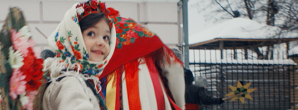-
 About & contacts
About & contacts
-
 Events
Events
-
 Web-project “Ukrainian culture”
Web-project “Ukrainian culture”
-
 Museum’s mission statement
Museum’s mission statement
-
 Exposition
Exposition
-
 Collection
Collection
-
 Ivan Honchar’s library
Ivan Honchar’s library
-
 Typical Ukrainians in the paintings of Ivan Honchar
Typical Ukrainians in the paintings of Ivan Honchar
-
 Ivan Honchar’s picturesque Ukraine
Ivan Honchar’s picturesque Ukraine
-
 Oasis of Ukrainian culture — Ivan Honchar Museum
Oasis of Ukrainian culture — Ivan Honchar Museum
-
 From the Guest book (1962-1988)
From the Guest book (1962-1988)
Ivan Makarovych Honchar was surrounded by Ukrainian folk art from childhood. He was born into a Ukrainian peasant family in the blessed homeland of Taras Shevchenko (Ukraine’s greatest poet). Village life, customs, folk costumes, the landscape, buildings in the folk architecture style, the artistic creativity of the people – all of these imbued his life, even when he was not home but studying in the Kyiv School of Art. From earliest childhood, Honchar portrayed his surroundings in the sculpture and painting that he loved so much. After becoming a professional sculptor, he traveled across all of Ukraine. His goal was to see, paint, and collect as many as possible of the best examples of Ukrainian folk creativity. Eventually his collection grew so large that he converted his home into an actual museum, which became the “home academy” for the artist.
Along with creating other works, in researching and popularizing the artistic heritage of the Ukrainian people, Ivan Honchar produced a series (in 18 volumes) of tempera and watercolor paintings of typical Ukrainians in their local regional folk costumes from the end of the 19th – beginning of the 20th centuries. The exceptionally artistic folk costumes are portrayed in Honchar’s paintings with academic precision. The slender figures stand in the foreground of the Ukrainian countryside, in harmony with their surroundings, set within the lyrical, typical landscape of each region. The basic elements of Ukrainian painting – richness of imagery, ornamentation, colorful palette, bright optimism, and monumentalism – became typical aspects of this artist’s work. His paintings, which convey the beauty of our land, people, and art, are indeed true folk art.
The artist’s objective was the anthropological and historic-ethnographic portrayal of the Ukrainian people in their life and ways.
In order to show even the smallest details of the folk costume, the artist portrays the figures filling the foreground of his paintings. But the detail is not just in the costume, because the people wearing the clothing are real, in casual poses, with natural gestures. The figures are placed naturally within the painting, either outdoors or in the interiors of village homes. Some stand at the perelaz [an opening in a fence for easy passage], or near a church, in the meadow or garden, alongside a wagon, wattle fence, or by the pond, with a sopilka [wooden flute], flowers, straw hat or kerchief in hand, or near a wall hung with a kylym or rushnyk [ritual cloth]. The artist employs two modes in showing his subjects: they are in motion, either doing everyday things, or participating in rituals and traditions (couples meeting, playing musical instruments, dancing, working, etc.); also, he rejects traditions of folk art, in that his people do not pose, but simply stand before the viewer of the painting. In presenting the art of the folk costume, he uses the local primary colors, without complicated tones. He does not attempt to recreate exactly the dimensions of the human form. But, in painting the landscape, he adheres to the rules of perspective and the finest coloring and shading of nature. Yet the various artistic modes are not dogmatic for the artist. He freely uses them as a means to achieve the most effective portrayal of typical Ukrainian villagers. Thus, chiaroscuro over local colors often creates the required nuances. Here the “non-picturesque” style of the artist acquires shading, and becomes figurative. Ivan Honchar’s documentary precision, the portrayal of motion, pose, and – to an extent – the mood of the person, a professional knowledge of anatomy and plasticity of the human form, the ability of presenting precise color and tone, and the use of the principles of tonal painting – all these combine into a whole. This entirety – with typical Ukrainian folk art ornamentation, proportion and dimension, compositional harmony, clarity of silhouette, simplicity of subject, along with written text within the painting – creates an original synthesis of professional and folk art.
While, for the artist, these paintings of Ukrainian village life are full of action, all attention is drawn to the emphasis on the individual portrayed. Even in the simplest life settings, his heroes are full of life and enthusiasm. Ivan Honchar portrays the best in people: the sense of dignity, beauty, and strength. Women convey gentle lyricism, attractiveness, grace; the men are masculine, strong, heroic. Physical and spiritual beauty unite. The emphasis on the person is demonstrated in the low horizon of the background, the distant views, which cause the viewer to focus on the human figure. The subjects in Honchar’s works are the free, original, self-sufficient, talented and beautiful people of Ukraine.
This brilliant original series of paintings by Ivan Makarovych Honchar, National Artist of the Ukrainian RSR, and recipient of the State Prize of Taras Shevchenko, is a major contribution not only to Ukrainian ethnography, but also to Ukrainian art in general.
Volodymyr PIDHORA,
Art Critic
[Introduction to the set of cards (reproductions): “Typical Ukrainians in the Paintings of Ivan Honchar.” Kyiv: Mystetstvo, 1990.]






















